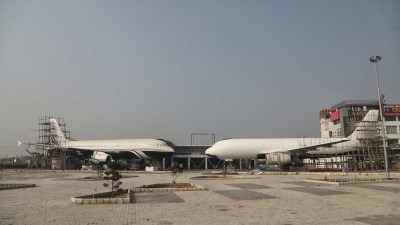Down in Jungleland: The Road to Ruin
Highways and aerodromes on wildlife spaces are terrible news. The proposed highway, it is said, will cut the distance between Kotdwar and Ramnagar by almost 80 km — imagine the savings in time and fuel. Also imagine some of the other things that are likely to happen.
 I remember how apprehensive I was watching a peacock running alongside the runway my plane was taxiing off from. (Source: Ranjit Lal)
I remember how apprehensive I was watching a peacock running alongside the runway my plane was taxiing off from. (Source: Ranjit Lal)
THE ONE surefire way to destroy a forest is to build a road through it. I couldn’t believe my eyes when I read that a plan was being hatched to build a highway through the heart of Corbett Tiger Reserve. Worse, an institution that was supposedly working for the interests of wildlife was going to help these brilliant minds in hatching the plot. Thankfully, at the time of writing, they’ve backed off.
The proposed highway, it is said, will cut the distance between Kotdwar and Ramnagar by almost 80 km — imagine the savings in time and fuel. Also imagine some of the other things that are likely to happen. First, they’ll start with clearing the forest with a battalion of JCB machines, which are not the quietest of machines. You can imagine the trauma it will cause to wildlife so far only accustomed to the dawn chorus of birds and the odd alarm call of monkeys and deer, or the occasional roar of a tiger. Next will come infantry divisions of labour to help hack down the trees and cart away their amputated boughs: too bad for the trees and anything which had a home in them or lived off their fruits, flowers, bark and leaves. This is followed by the stink of hot tar and cement, and the clatter of rocks being cut into chips by hundreds of labourers. Heavy vehicles belching diesel fumes will lurch all over the place. This will go on for years. Eventually, on one auspicious day, a minister will cut the ribbon, get into his SUV and drive a little distance down the highway, to inaugurate it. And after that, it’ll be open season for all the rabid vehicle drivers in the country — there will be speed limits, maybe speed bumps, too. But traffic will thunder up and down the road incessantly, still. Zebra crossings for wildlife? Since we don’t stop or slow down at a zebra crossing for people, are we going to do that for a family of jackals?
By now, dhaba and restaurant owners will be eyeing this highway speculatively. And from dhabas and restaurants to hotels and resorts is just a small step for mankind (provided you know the right men). If you’re worried about being attacked by wildlife, be rest assured! “Tigers? Elephants? Nahin bhai sahib, they don’t come here anymore, they don’t like the road — you’ll be safe!”
There’s an even more harebrained idea of establishing a seaplane aerodrome on Chilika lake in Odisha. Chilika lake is the largest brackish water wetland in India and attracts as many as 8,00,000 head of migratory waterfowl in winter. Now, if there is one universal truth that every child knows, it is that planes and birds should not share the same airspace at the same time. Every commercial airport has bird-scarers on its staff, which lets off fireworks or shoot off blanks to scare away birds. I remember how apprehensive I was once, while watching a peacock running alongside the runway my plane was taxiing along before takeoff. And what do we have here? Seaplanes coming into land or revving up for takeoff amidst a flock of, say, 1,000 ducks — who tend to panic into mass take-offs when the merest shadow of a marsh harrier passes over them, forget about a monstrous droning machine, diving towards them or churning up the water.
Sooner rather than later, there’s going to be a duck or goose flying in through the windshield and into the commander’s lap, or, being minced by the propellers and sucked into the intakes. Most modern planes have TCAS (Traffic Collision Avoidance System), an automatic collision avoidance system, which instructs one pilot to pull and the other to lose height if two planes approach too close at the same altitude. Birds have their own version of TCAS, which enables them to perform all those high-speed wingtip to wingtip formation flights without banging into one another. But there’s no system to tell a commander to pull up and the leading goose to dive with its flock as they head directly towards one another. Perhaps, those brilliant planners will tell us: we can always have bird-scarers at a bird sanctuary, can’t we?


- 01
- 02
- 03
- 04
- 05





























